World class ceramic water filters Since 1827 |
|
Doulton Water Filter Ceramic Candle & Cartridge Technologies, taking the mysteries out of the drinking water filtrationCeramics, a natural water filter - Sterasyl micro-filter
|
Most Popular Water Purification Technologies for Domestic Drinking Use (FAQ)
* Activated Carbon (AC)
|
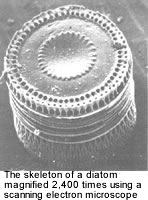 Doulton mines only the finest and purest kieselguhr or diatom
earth often described as a silica-like sediment resulting from
kiesel algae (one celled algae) deposited on the bottom of geological
lakes and lagoons millions of years ago. This is the same material
used in making the finest bone china (like of Royal Doulton) and numerous other applications.
Doulton mines only the finest and purest kieselguhr or diatom
earth often described as a silica-like sediment resulting from
kiesel algae (one celled algae) deposited on the bottom of geological
lakes and lagoons millions of years ago. This is the same material
used in making the finest bone china (like of Royal Doulton) and numerous other applications.
 The
filter elements are produced using the latest ceramic techniques to
provide a hollow porous ceramic which is fired at a temperature in
excess of 1000°C. The chemically inert ceramic filter can be stored
for eternity without losing its effectiveness.
The
filter elements are produced using the latest ceramic techniques to
provide a hollow porous ceramic which is fired at a temperature in
excess of 1000°C. The chemically inert ceramic filter can be stored
for eternity without losing its effectiveness.
Doulton ceramic filter particles from the water but leaves oxygen and mineral
contents unchanged, which gives water it's spring-like freshness and
taste (not "pure" but wholesome). Pathogens of the most
varied diseases which are reliably filtered from the water include; cholera, typhus, cryptosporidium, amoebic dysentery, ecoli, colibacillose
or bilharzia, anthrax spores among others.
Ceramic filtration technology is often called "dead-end
filtration” and "depth filtration".
There are several mechanisms by which the ceramic element filters out particles as a dead-end filtration.

a) Direct interception or sieving (fig. 1): Particle of 0.5 µm and larger "runs into" a pore that is smaller than the particle of topmost layer of the ceramic and are captured as with absolute pore rated synthetic dead-end membranes.
 b) Bridging (fig. 2): Smaller than 0.5 µm particles may be too small to be intercepted
b) Bridging (fig. 2): Smaller than 0.5 µm particles may be too small to be intercepted 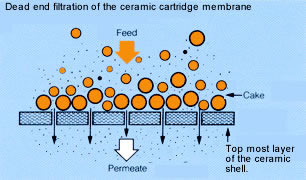 however two particles hitting the obstruction at the same time will form a bridge across the pore adhering to each other. Bridged particles may not plug the pore creating even smaller pore gradually forming a "filter cake". This "cake" creates a finer filtration for subsequent interception at the cost of decreased flow rate and eventually no flow rate.
however two particles hitting the obstruction at the same time will form a bridge across the pore adhering to each other. Bridged particles may not plug the pore creating even smaller pore gradually forming a "filter cake". This "cake" creates a finer filtration for subsequent interception at the cost of decreased flow rate and eventually no flow rate.
Mechanical regeneration of the filter "cake" is simple. The topmost blocked layer can be removed with stiff brush or nylon scouring pad. This can be repeated many times before the filter has to be changed.
 c) Inertial impaction (fig. 3): Particles flowing through the filter hits none porous surface barrier it become captured while the water flows around the barrier. Inertial impaction is more prevalent with smaller particles in range of 0.1 to 0.4 µm size as these particles are easily affected by molecular bombardment.
c) Inertial impaction (fig. 3): Particles flowing through the filter hits none porous surface barrier it become captured while the water flows around the barrier. Inertial impaction is more prevalent with smaller particles in range of 0.1 to 0.4 µm size as these particles are easily affected by molecular bombardment.
Unlike with synthetic membranes, all of the above methods of capture are dependable under variable operating conditions e.g. pressure surging, pulsing etc. with Doulton ceramics.
Ceramic depth filtration will filter out considerably smaller particles than equivalent pore size membrane for the following reasons:
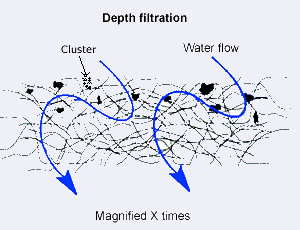 a)Particles intercepted within the ceramic depth are much smaller than the pores measured by porometry. This is because particle laden
water has to navigate through intricate maze of labyrinths. The path through the filter twists and turns trough sharp angles due to complicated ceramic structure and so the particles that may have penetrated the topmost layer become trapped within the structure.
a)Particles intercepted within the ceramic depth are much smaller than the pores measured by porometry. This is because particle laden
water has to navigate through intricate maze of labyrinths. The path through the filter twists and turns trough sharp angles due to complicated ceramic structure and so the particles that may have penetrated the topmost layer become trapped within the structure.
To appreciate the distance and how difficult a path the water has to follow, consider that the wall thickness of the ceramic is 1000-2000 times greater than the pore size of the ceramic filter and the pores are sharp and jagged rather than smooth and round.
b) Small particles can combine with other particles to form a cluster of particles large enough to become trapped as a group or individual in dead end cavities.
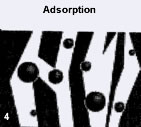 c) Weak Van der Waals forces (adsorption fig. 4) attract the small particles to the ceramic, causing them to be adsorbed onto the wall of the ceramic. Depth filtration is very dependable as pressure surges are not affecting adsorption because the pressure is stabilized (drops by 50%) on the surface of the ceramic. Doulton ceramic depth filtration captures particles as small as 0.05 µm with greater than 90% efficiency.
c) Weak Van der Waals forces (adsorption fig. 4) attract the small particles to the ceramic, causing them to be adsorbed onto the wall of the ceramic. Depth filtration is very dependable as pressure surges are not affecting adsorption because the pressure is stabilized (drops by 50%) on the surface of the ceramic. Doulton ceramic depth filtration captures particles as small as 0.05 µm with greater than 90% efficiency.
Given favourable conditions, the accumulated bacteria could proliferate and grow unless prevented by some means.
To prevent this Doulton elements (except the Standard, Ceracarb and Ceramet) are manufactured with a small amount (about 0.07%) of pure silver (Ag) through-out the porous ceramic shell. Silver is a recognized bactericide, so when the bacteria comes into contact with the silver impregnated ceramic, their growth is inhibited. This self-sterilizing effect is known as the bacteriostatic effect.

Free silver ions (Ag+) have a toxic effect on micro-organisms even in relatively
low concentrations. They have a highly fungicidal, bactericidal and
algaecidel effect. Medical studies describe silver ions a catalyst
that disable the enzymes that microorganisms depend on to "breathe".
 In
the presence of air (oxygen in water), metallic silver forms silver
oxide, which also has a bactericidal effect due to its adequate solubility.
The destruction of viruses, bacteria, moulds, spores and fungi through
contact with silver objects is termed the oligodynamic effect.
To primitive life forms, oligodynamic silver is as toxic as the most
powerful chemical disinfectants. This, coupled with its relative harmlessness
to animate life (i.e. mammals), gives oligodynamic silver great potential
as a disinfectant. (I.E. click refresh button to see silver animation)
In
the presence of air (oxygen in water), metallic silver forms silver
oxide, which also has a bactericidal effect due to its adequate solubility.
The destruction of viruses, bacteria, moulds, spores and fungi through
contact with silver objects is termed the oligodynamic effect.
To primitive life forms, oligodynamic silver is as toxic as the most
powerful chemical disinfectants. This, coupled with its relative harmlessness
to animate life (i.e. mammals), gives oligodynamic silver great potential
as a disinfectant. (I.E. click refresh button to see silver animation)
The best and most environmentally-friendly silver based disinfectants are capable of rendering stored water potable for long period of time as in space stations.
Due to their tiny size, viruses, theoretically cannot be removed with a 0.2 micron or higher rated absolute filter (or any mechanical filter for that matter). If virus is a concern simply add a commercially available disinfectant such as silver (e.g. Katadyn's Micropur®) or iodine tablets. Doulton Supersterasyl candle will remove the unpleasant taste and odours of the iodine.
Physically viruses have electrical surface charge that attaches them to other larger particles (free ride). The tight pore-structure of any absolute sub-micron water filter (e.g. Doulton, Katadyn etc.) can remove "free ride" viruses however due to many variables no device should be relied upon viral control.

 Doulton
uses high quality carbon blends obtained from different raw materials
such as lignite, bituminous coal and coconut shells. Active carbon
is used for water treatment due to its adsorbing effect with
respect to organic and health endangering chemicals.
Doulton
uses high quality carbon blends obtained from different raw materials
such as lignite, bituminous coal and coconut shells. Active carbon
is used for water treatment due to its adsorbing effect with
respect to organic and health endangering chemicals.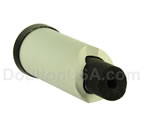
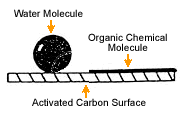 Activated
carbon surfaces are both hydrophobic and oleophilic;
that is, they “hate” water but “love” oil. When flow conditions are
suitable, dissolved chemicals in water flowing through the carbon media “stick” to the carbon surface in a thin film while the water passes on. This
process is call adsorption.
Activated
carbon surfaces are both hydrophobic and oleophilic;
that is, they “hate” water but “love” oil. When flow conditions are
suitable, dissolved chemicals in water flowing through the carbon media “stick” to the carbon surface in a thin film while the water passes on. This
process is call adsorption.
Substances affecting taste and odours such as chlorine, pesticides (lindane, DDT) and trihalogenmethanes (THM's) are removed by activated carbon. These substances are adsorbed on the large surface area of the active carbon. For visual purpose, one teaspoon of activated carbon have a surface area the size of a football field.
Active carbon is available in granulate (GAC filters), powder (PAC filters) or extruded solid carbon block form (CB filters).
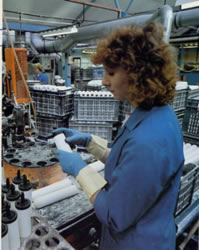 Sterasyl membrane: (candle and cartridge form): Used for microbiological removal.
The only ceramic element in the world to meet the stringent NSF antimony and arsenic extraction test featuring:
Sterasyl membrane: (candle and cartridge form): Used for microbiological removal.
The only ceramic element in the world to meet the stringent NSF antimony and arsenic extraction test featuring:
Typical application: UV, RO and ozone pre-filter, point-of-use (POU) final polish filter, zero cyst tolerance in bottling water plants using our industrial multi cartridge filters and various other application requiring absolute filtration. Least expensive absolute filter on the market as it is cleanable and reusable for up 60 times. Backwash capable, self-sterilized, no bacteria grow through as encountered in most all synthetic membranes.
Available in candle and open both ends (DOE) cartridge style.
Supersterasyl candle: Used in British Berkefeld gravity filters is a Sterasyl shell packed with granular activated carbon. Available in 2"x7", 2.75"x7" and 2"x10" candle style with long threaded end cap. Custom size and end caps configuration available with minimum kiln firing requirements of 2400 units for all grades of elements.
Carbosyl elements: Sterasyl shell lined with fine activated carbon coating impregnated throughout the ceramic pore structure then re-fired in excess of 1000°C. Soon to introduce our inline filter fitted with Carbosyl candle as a replacement for the RO GAC final polish filter to control heterotrophic plate count (HPC)* bacteria commonly found in virtually all inexpensive RO systems. Available in 2" slimline and 2.75"x9.75" Imperial cartridge in case quantity by special order. 25 pcs. slimline and 9 pcs. per case Imperial size.
Supercarb ceramic elements: Used in all residential pressure filters is a Sterasyl shell with solid carbon block insert. Economical three stage filtration available in candle and cartridge style.
Ultracarb ceramic elements: Used in all pressure filters is a Supercarb with ATS ion exchange medium incorporated into the carbon block for heavy metal reduction. Economical four stage filtration available in candle and cartridge style.
Supercarb-Ultracarb comparison table
Conclusion: Doulton ceramic filters are designed to convert raw water into high quality drinking water that will comply with the most stringent potable water standards all 100% naturally.
* Heterotrophic (HPC) is a harmless bacteria commonly found in all waters. In absence of disinfectants this bacteria colonize the reverse osmosis holding tank. As the bacteria die it creates foul odor therefore all RO's have GAC final filter to remove the odor out of the water. It should be clearly understood that no GAC filter remove any bacteria.
Check and compare other water treatment technologies>>
WHY CHOOSE A CERAMIC WATER FILTER>>
Site Plan Residential Ceramic Water Purifiers Whole House Water Filtration/Conditioning Systems Portable Gravity Fed Filters Commercial Kitchen Equipment Industrial Water Purification Systems Boats and RV's Fresh Water Systems Filter Replacement Ceramic Candles and Cartridges Faucets for Water Filters ALL PRODUCTS LIST
